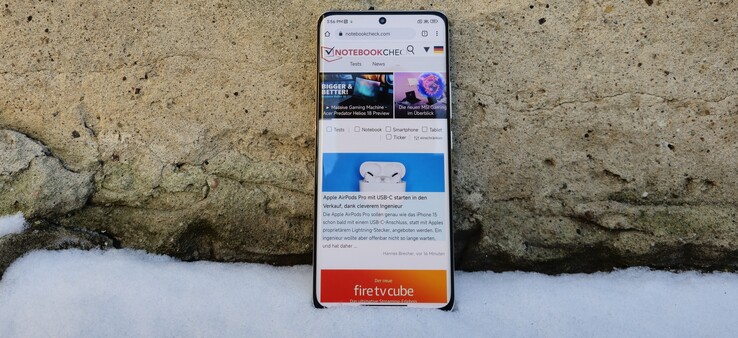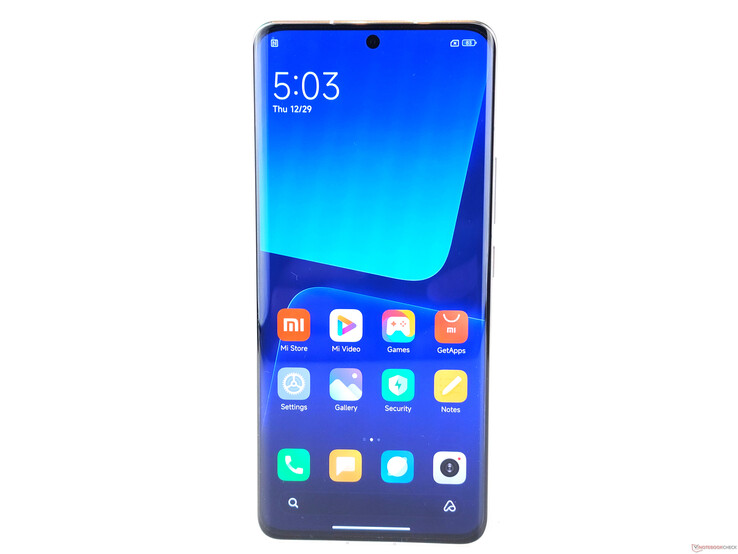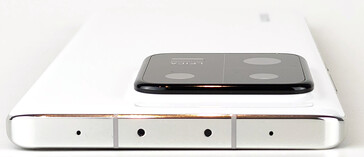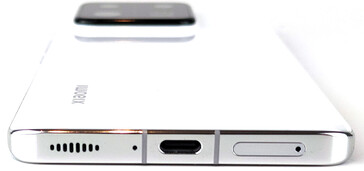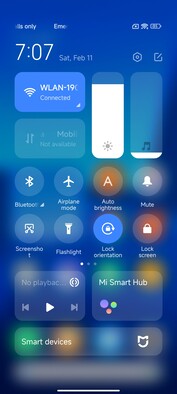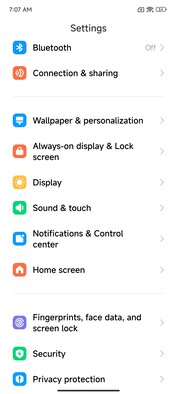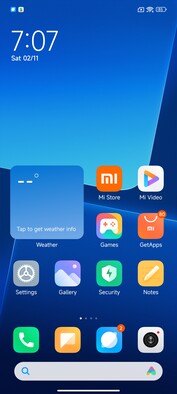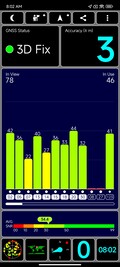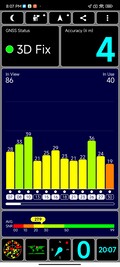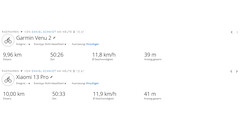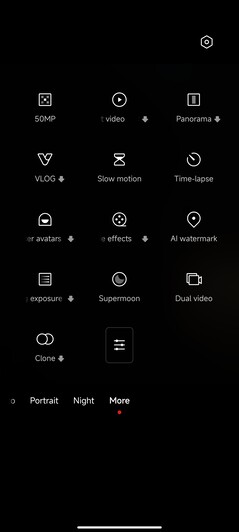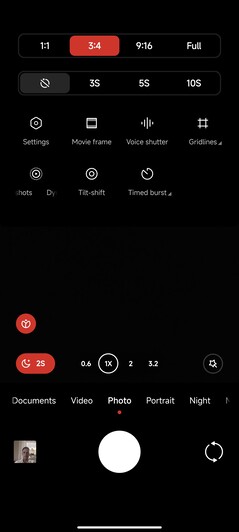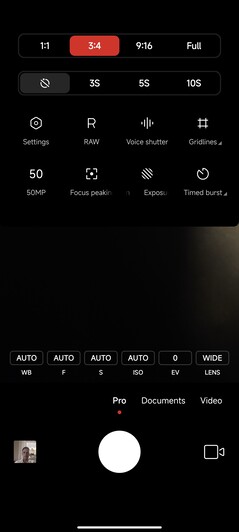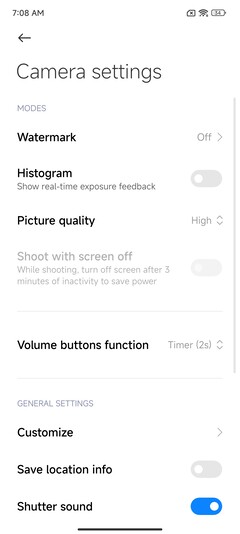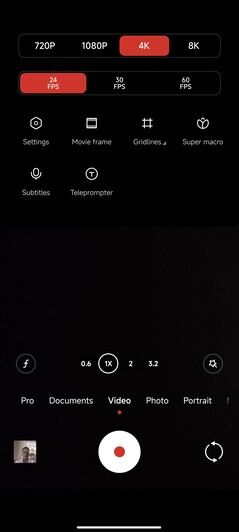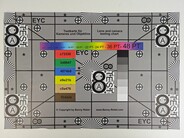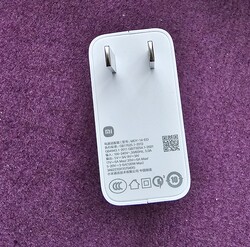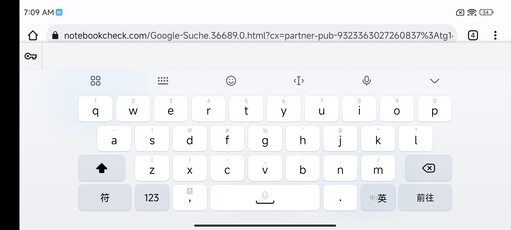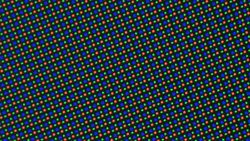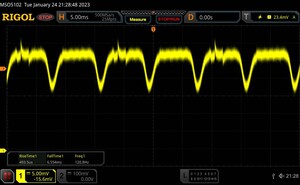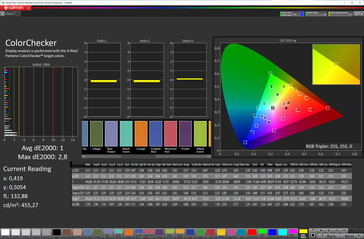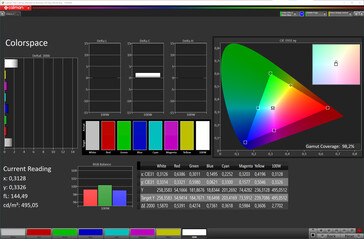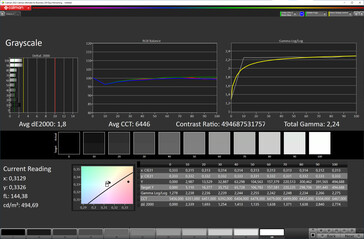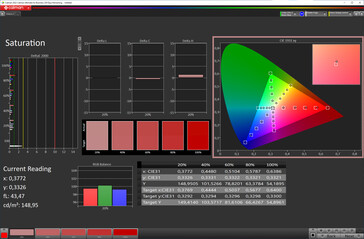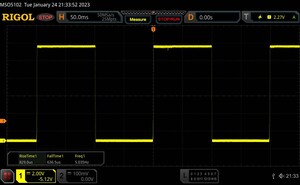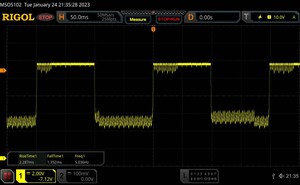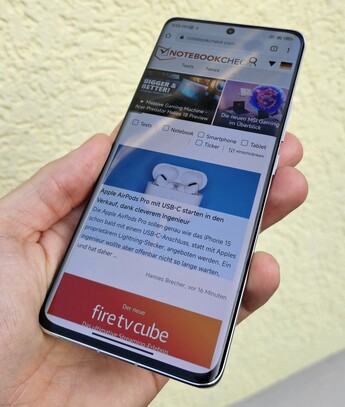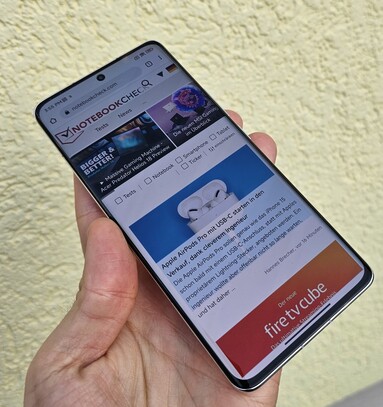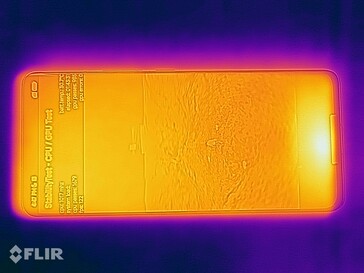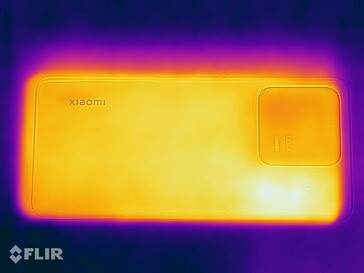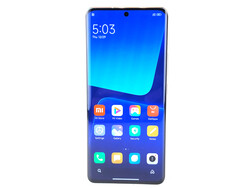小米13 Pro评测。配备徕卡相机的高质量智能手机,但也有两个主要缺点
小米12 Pro的继任者 ,自去年年底以来已经在中国市场上市,正如预期的那样,它采用了非常强大的组件。除了快速的LPDDR5X内存和UFS 4.0存储,小米13 Pro还采用了高通骁龙8号2代 。国际上市仍在等待中,但应该在几周后--2月底, 。作为一款进口设备,配备8GB内存和256GB内部存储的入门级版本的价格约为800美元。
这家中国制造商目前的旗舰产品(至少在预期的Ultra机型推出之前)主要侧重于摄影。与12S机型一样,13 Pro的相机系统是与德国公司徕卡合作创建的。1英寸的索尼IMX989,从12S Ultra中得知。 12S Ultra作为主摄像头的基础,它应该保证良好的照片。但是,新的5000万像素长焦相机带有 "浮动元素 "功能,可进行10厘米以内的特写,听起来也很有希望。
潜在的竞争对手比较
Rating | Date | Model | Weight | Drive | Size | Resolution | Price |
|---|---|---|---|---|---|---|---|
| 89.2 % v7 (old) | 03 / 2023 | Xiaomi 13 Pro SD 8 Gen 2, Adreno 740 | 229 g | 256 GB UFS 4.0 Flash | 6.73" | 3200x1440 | |
| 87.6 % v7 (old) | 02 / 2022 | Xiaomi 12 Pro SD 8 Gen 1, Adreno 730 | 204 g | 256 GB UFS 3.1 Flash | 6.73" | 3200x1440 | |
| 90 % v7 (old) | 02 / 2023 | Vivo X90 Pro+ SD 8 Gen 2, Adreno 740 | 221 g | 256 GB UFS 4.0 Flash | 6.78" | 3200x1440 | |
| 89.1 % v7 (old) | 11 / 2022 | Google Pixel 7 Pro Tensor G2, Mali-G710 MP7 | 212 g | 128 GB UFS 3.1 Flash | 6.70" | 3120x1440 | |
| 89.4 % v7 (old) | 03 / 2022 | Samsung Galaxy S22 Ultra 5G Exynos 2200, Xclipse 920 | 228 g | 128 GB UFS 3.1 Flash | 6.80" | 3088x1440 | |
| 88.9 % v7 (old) | 11 / 2022 | Huawei Mate 50 Pro SD 8+ Gen 1, Adreno 730 | 209 g | 256 GB UFS 3.1 Flash | 6.70" | 2616x1212 |
保护壳 - 小米13 Pro陶瓷保护壳
» Notebookcheck多媒体笔记本电脑Top 10排名
» Notebookcheck游戏笔记本电脑Top 10排名
» Notebookcheck低价办公/商务笔记本电脑Top 10排名
» Notebookcheck高端办公/商务笔记本电脑Top 10排名
» Notebookcheck工作站笔记本电脑Top 10排名
» Notebookcheck亚笔记本电脑Top 10排名
» Notebookcheck超级本产品Top 10排名
» Notebookcheck变形本产品Top 10排名
» Notebookcheck平板电脑Top 10排名
» Notebookcheck智能手机Top 10排名
» Notebookcheck评测过最出色的笔记本电脑屏幕
» Notebookcheck售价500欧元以下笔记本电脑Top 10排名
» Notebookcheck售价300欧元以下笔记本电脑Top 10排名
设备--小米智能手机与红外辐射器
小米为其13 Pro提供了快速的UFS 4.0存储,容量为256 GB或512 GB。在选择存储空间时,应牢记不支持microSD。在USB速度方面,小米没有说明其中国网站上安装的USB-C端口的类型,但第一代或第二代的快速USB 3.2端口,工作时数据传输率高,支持有线图像输出,继续令人遗憾地缺席。这里再次使用了2.0标准。
小米智能手机的其他硬件功能包括蓝牙5.3、UWB芯片、屏幕内容的无线图像传输(Miracast)、红外辐射器,以及用于快速连接U盘等外部配件的USB OTG。当然也有一个NFC芯片,包括Play Protect认证。
软件 - 小米13 Pro与Android 13
小米在14版中把Android 13与自己的MIUI用户界面相结合。然而,从2022年10月开始的安全补丁并没有保持相当的更新。
的更新保证。小米12系列,即三个主要的Android 更新和四年的安全更新,可能也将适用于欧洲的13系列--小米的高端智能手机将因此更新到Android 16和MIUI 17。然而,购买Galaxy 的S系列智能手机的人,仍然可以得到更多的支持,有四个主要的Android 更新和五年的安全补丁。
与中国版本一样,我们的评测样本不支持谷歌服务,如PlayStore。相反,使用的是中国服务和小米自己的服务。但与华为智能手机不同,你不必没有谷歌服务。谷歌服务框架在交货时已经预装,所以只有PlayStore需要通过内部应用商店手动安装。然而,除了中文和英文之外,没有其他系统语言可以选择。
通信和GNSS - 小米13 Pro带WiFi 7
在家庭无线局域网内,小米13 Pro提供了WiFi 7的快速轴标准,包括6GHz的频率范围,加上(MU-)MIMO技术,在我们的测量中确保了非常高的传输速率。结合我们的华硕ROG Rapture GT-AXE11000参考路由器,小米智能手机在6GHz范围内实现了超过1800MBit/s,在5GHz以下传输时几乎达到1000MBit/s。
除了快速WLAN模块,13 Pro还利用了骁龙X70调制解调器,包括5G标准,但不支持毫米波。此外,我们中国版的小米智能手机支持访问总共16个LTE频段--但与德语国家相关的20和28频段却没有。这个问题将随着小米13 Pro欧洲版本的发布而得到解决,类似于小米12 Pro,它的LTE频率明显多于其中国版本。
| Networking | |
| Xiaomi 13 Pro | |
| iperf3 receive AXE11000 | |
| iperf3 transmit AXE11000 | |
| iperf3 transmit AXE11000 6GHz | |
| iperf3 receive AXE11000 6GHz | |
| Xiaomi 12 Pro | |
| iperf3 receive AXE11000 | |
| iperf3 transmit AXE11000 | |
| Vivo X90 Pro+ | |
| iperf3 receive AXE11000 | |
| iperf3 transmit AXE11000 | |
| Google Pixel 7 Pro | |
| iperf3 receive AXE11000 | |
| iperf3 transmit AXE11000 | |
| iperf3 transmit AXE11000 6GHz | |
| iperf3 receive AXE11000 6GHz | |
| Samsung Galaxy S22 Ultra 5G | |
| iperf3 receive AXE11000 | |
| iperf3 transmit AXE11000 | |
| iperf3 transmit AXE11000 6GHz | |
| iperf3 receive AXE11000 6GHz | |
| Huawei Mate 50 Pro | |
| iperf3 receive AXE11000 | |
| iperf3 transmit AXE11000 | |
| Average of class Smartphone | |
| iperf3 receive AXE11000 | |
| iperf3 transmit AXE11000 | |
| iperf3 transmit AXE11000 6GHz | |
| iperf3 receive AXE11000 6GHz | |
电话和语音质量 - 小米双卡智能手机
相机 - 小米智能手机的1英寸传感器
与前代产品相比,小米13 Pro的前置摄像头变化不大。自拍摄像头具有3200万像素的高分辨率,可以提供非常令人印象深刻的照片,具有很高的细节水平。然而,值得注意的是,在 "经典模式 "下,图像会大大曝光过度。
尽管前置摄像头的分辨率很高,但视频录制只可能在30帧/秒的情况下最多达到1080p。竞争对手的智能手机,如三星Galaxy S22 Ultra提供更多的60帧的UHD质量。
背面是1英寸的索尼IMX989,来自小米12S Ultra ,配有OIS。与12S机型一样,小米宣传其与徕卡的合作,这不仅围绕软件,还包括镜头的光学ALD涂层。照片有广泛的图像动态和大量的细节。由于1英寸的传感器,背景大多是模糊的,即使在照片模式下也是如此,这给了照片一种特殊的感觉。用小米13 Pro拍摄的照片不像竞争对手那样经常过度锐化,但我们偶尔会发现照片有点过于柔和。除了一个非常有趣的5000万像素长焦微距摄像头(包括OIS),主摄像头还得到一个超广角摄像头的支持,也是5000万像素。
徕卡在相机软件中提供 "活力 "和 "真实 "模式。第一种模式使色彩更加饱和和明亮,而第二种模式再现了 "徕卡风格 "的镜头,突出了光线和阴暗区域。我们的图像对比照片是在 "Leica Authentic "模式下拍摄的。
具有3.2倍无损变焦的长焦镜头是基于内部的液体镜头设计,其中包括一个浮动镜头组。镜头分为两组,可以在内部移动,允许聚焦范围从10厘米到理论上的无限远。变焦后的照片具有扎实的基本清晰度,可达到五倍的放大率,这比前者有明显的改进。前代产品.然而,其他高端智能手机,如 Vivo X90 Pro+,有明显更好的变焦质量。
超广角相机很好地控制了镜头的弧度;我们没有发现任何色差。然而,锐度水平不是很明显,特别是在外围区域。
小米13 Pro用主摄像头以24帧/秒的最高8K速度记录动态图片。UHD质量的视频可以以每秒60帧的速度录制。只有在以1080p录制时,才可以在镜头之间切换。
Image comparison
Choose a scene and navigate within the first image. One click changes the position on touchscreens. One click on the zoomed-in image opens the original in a new window. The first image shows the scaled photograph of the test device.
Main cameraMain cameraLow lightUltra wide angleZoom 5x我们仔细观察了1英寸索尼传感器在受控照明条件下的成像性能。在P3配置文件中,小米13 Pro的内置OLED面板能够完全覆盖色彩空间,与sRGB相比,色彩空间相当大,因此徕卡校准的宽色彩空间也能完全显示。与参考颜色的偏差在典型的智能手机范围内;颜色经常被复制得有点太亮,特别是在绿色调中。
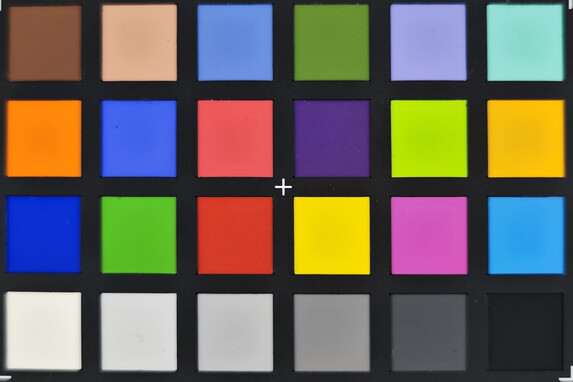
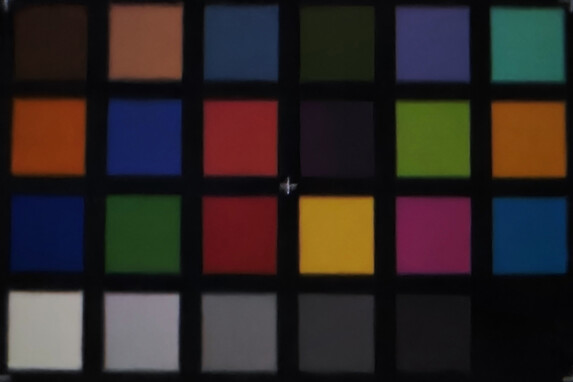
配件和保修 - 小米13 Pro带电源装置
输入设备和操作 - 小米手机的FaceUnlock功能
显示屏 - 小米智能手机采用OLED
6.73英寸的LTPO AMOLED显示屏,侧面略有弯曲,来自三星,提供WQHD+分辨率,动态刷新率从1赫兹到120赫兹--我们也可以在系统数据中获取这些数值。然而,为了能够享受10位面板的高像素密度(521 ppi),必须首先在设置中停用出厂默认的FullHD+分辨率。
小米13 Pro的最大亮度被规定为1,900尼特。在纯白的表面上,AMOLED面板在我们的测量中实现了1290cd/m²的峰值,非常好。如果我们在显示屏上抛出一些黑暗区域,亮度会显著增加,在APL18测试中达到1798cd/m²。因此,在我们的测量中,小米智能手机确实非常接近制造商的规格。在,最近的情况往往不是这样的。.
像所有OLED显示屏一样,小米13 Pro的屏幕在整个亮度范围内都会闪烁。我们测量的频率为120赫兹,最高亮度为59%,振幅曲线平缓。在这个亮度极限以上,面板在361和366赫兹之间闪烁。
| |||||||||||||||||||||||||
Brightness Distribution: 94 %
Center on Battery: 1230 cd/m²
Contrast: ∞:1 (Black: 0 cd/m²)
ΔE ColorChecker Calman: 1 | ∀{0.5-29.43 Ø4.78}
ΔE Greyscale Calman: 1.8 | ∀{0.09-98 Ø5}
98.2% sRGB (Calman 2D)
Gamma: 2.24
CCT: 6446 K
| Xiaomi 13 Pro OLED, 3200x1440, 6.7" | Xiaomi 12 Pro AMOLED, 3200x1440, 6.7" | Vivo X90 Pro+ AMOLED, 3200x1440, 6.8" | Google Pixel 7 Pro OLED, 3120x1440, 6.7" | Samsung Galaxy S22 Ultra 5G Dynamic AMOLED, 3088x1440, 6.8" | Huawei Mate 50 Pro AMOLED, 2616x1212, 6.7" | |
|---|---|---|---|---|---|---|
| Screen | -11% | -6% | 7% | 3% | -15% | |
| Brightness middle (cd/m²) | 1230 | 959 -22% | 1109 -10% | 1022 -17% | 1077 -12% | 940 -24% |
| Brightness (cd/m²) | 1244 | 977 -21% | 1124 -10% | 1025 -18% | 1093 -12% | 945 -24% |
| Brightness Distribution (%) | 94 | 96 2% | 96 2% | 99 5% | 97 3% | 92 -2% |
| Black Level * (cd/m²) | ||||||
| Colorchecker dE 2000 * | 1 | 1.1 -10% | 1.1 -10% | 0.9 10% | 1.2 -20% | 1.18 -18% |
| Colorchecker dE 2000 max. * | 2.8 | 3.1 -11% | 2.7 4% | 2.1 25% | 2 29% | 2.86 -2% |
| Greyscale dE 2000 * | 1.8 | 1.9 -6% | 2 -11% | 1.1 39% | 1.3 28% | 2.1 -17% |
| Gamma | 2.24 98% | 2.22 99% | 2.25 98% | 2.22 99% | 2.37 93% | 2.217 99% |
| CCT | 6446 101% | 6498 100% | 6605 98% | 6650 98% | 6526 100% | 6352 102% |
* ... smaller is better
Screen Flickering / PWM (Pulse-Width Modulation)
| Screen flickering / PWM detected | 120 Hz | ||
The display backlight flickers at 120 Hz (worst case, e.g., utilizing PWM) . The frequency of 120 Hz is very low, so the flickering may cause eyestrain and headaches after extended use. In comparison: 53 % of all tested devices do not use PWM to dim the display. If PWM was detected, an average of 8111 (minimum: 5 - maximum: 343500) Hz was measured. | |||
在固定的变焦水平和不同的亮度设置下进行的一系列测量
Display Response Times
| ↔ Response Time Black to White | ||
|---|---|---|
| 1.47 ms ... rise ↗ and fall ↘ combined | ↗ 0.829 ms rise | |
| ↘ 0.6365 ms fall | ||
| The screen shows very fast response rates in our tests and should be very well suited for fast-paced gaming. In comparison, all tested devices range from 0.1 (minimum) to 240 (maximum) ms. » 7 % of all devices are better. This means that the measured response time is better than the average of all tested devices (20.2 ms). | ||
| ↔ Response Time 50% Grey to 80% Grey | ||
| 3.64 ms ... rise ↗ and fall ↘ combined | ↗ 2.287 ms rise | |
| ↘ 1.352 ms fall | ||
| The screen shows very fast response rates in our tests and should be very well suited for fast-paced gaming. In comparison, all tested devices range from 0.165 (minimum) to 636 (maximum) ms. » 13 % of all devices are better. This means that the measured response time is better than the average of all tested devices (31.6 ms). | ||
性能 - 采用高通SoC的小米13 Pro
在目前的Android 阵营中,它并不比小米13 Pro快多少。骁龙8代2在我们的基准测试中表现非常好,通常会把竞争对手甩在后面。其原因是新的冷冻CPU由四个集群组成,具有不同的ARM架构,包括快速的主核(Cortex-X3),频率高达3.2GHz。
高通公司的SoC在基准测试中表现得非常好。特别是在Geekbench中的多核值非常高。在这里,小米已经能够将性能比12 Pro提高三分之一以上。12 Pro。高通SoC在PCMark中也表现良好。
| UL Procyon AI Inference for Android - Overall Score NNAPI | |
| Xiaomi 12 Pro | |
| Google Pixel 7 Pro | |
| Average of class Smartphone (3769 - 81594, n=139, last 2 years) | |
| Vivo X90 Pro+ | |
| Xiaomi 13 Pro | |
| Average Qualcomm Snapdragon 8 Gen 2 (11338 - 16880, n=21) | |
| Samsung Galaxy S22 Ultra 5G | |
| Huawei Mate 50 Pro | |
在图形测试中, Adreno 740也表现得非常好,有时比同样使用了骁龙8代2.0的vivo X90 Pro+领先近20%。 骁龙8代2.
GFXBench (DX / GLBenchmark) 2.7: T-Rex Onscreen | 1920x1080 T-Rex Offscreen
GFXBench 3.0: on screen Manhattan Onscreen OGL | 1920x1080 1080p Manhattan Offscreen
GFXBench 3.1: on screen Manhattan ES 3.1 Onscreen | 1920x1080 Manhattan ES 3.1 Offscreen
GFXBench: on screen Car Chase Onscreen | 1920x1080 Car Chase Offscreen | on screen Aztec Ruins High Tier Onscreen | 2560x1440 Aztec Ruins High Tier Offscreen | on screen Aztec Ruins Normal Tier Onscreen | 1920x1080 Aztec Ruins Normal Tier Offscreen
| 3DMark / Wild Life Extreme Unlimited | |
| Xiaomi 13 Pro | |
| Vivo X90 Pro+ | |
| Huawei Mate 50 Pro | |
| Xiaomi 12 Pro | |
| Samsung Galaxy S22 Ultra 5G | |
| Google Pixel 7 Pro | |
| 3DMark / Wild Life Extreme | |
| Xiaomi 13 Pro | |
| Vivo X90 Pro+ | |
| Huawei Mate 50 Pro | |
| Xiaomi 12 Pro | |
| Samsung Galaxy S22 Ultra 5G | |
| Google Pixel 7 Pro | |
| 3DMark / Wild Life Unlimited Score | |
| Vivo X90 Pro+ | |
| Xiaomi 13 Pro | |
| Huawei Mate 50 Pro | |
| Xiaomi 12 Pro | |
| Samsung Galaxy S22 Ultra 5G | |
| Google Pixel 7 Pro | |
| GFXBench (DX / GLBenchmark) 2.7 / T-Rex Onscreen | |
| Xiaomi 12 Pro | |
| Google Pixel 7 Pro | |
| Vivo X90 Pro+ | |
| Xiaomi 13 Pro | |
| Samsung Galaxy S22 Ultra 5G | |
| Huawei Mate 50 Pro | |
| GFXBench (DX / GLBenchmark) 2.7 / T-Rex Offscreen | |
| Xiaomi 13 Pro | |
| Vivo X90 Pro+ | |
| Huawei Mate 50 Pro | |
| Xiaomi 12 Pro | |
| Samsung Galaxy S22 Ultra 5G | |
| Google Pixel 7 Pro | |
| GFXBench 3.0 / Manhattan Onscreen OGL | |
| Xiaomi 13 Pro | |
| Vivo X90 Pro+ | |
| Xiaomi 12 Pro | |
| Samsung Galaxy S22 Ultra 5G | |
| Google Pixel 7 Pro | |
| Huawei Mate 50 Pro | |
| GFXBench 3.0 / 1080p Manhattan Offscreen | |
| Xiaomi 13 Pro | |
| Vivo X90 Pro+ | |
| Huawei Mate 50 Pro | |
| Xiaomi 12 Pro | |
| Samsung Galaxy S22 Ultra 5G | |
| Google Pixel 7 Pro | |
| GFXBench 3.1 / Manhattan ES 3.1 Onscreen | |
| Xiaomi 13 Pro | |
| Vivo X90 Pro+ | |
| Xiaomi 12 Pro | |
| Samsung Galaxy S22 Ultra 5G | |
| Huawei Mate 50 Pro | |
| Google Pixel 7 Pro | |
| GFXBench 3.1 / Manhattan ES 3.1 Offscreen | |
| Xiaomi 13 Pro | |
| Vivo X90 Pro+ | |
| Huawei Mate 50 Pro | |
| Xiaomi 12 Pro | |
| Samsung Galaxy S22 Ultra 5G | |
| Google Pixel 7 Pro | |
| GFXBench / Car Chase Onscreen | |
| Xiaomi 13 Pro | |
| Vivo X90 Pro+ | |
| Huawei Mate 50 Pro | |
| Samsung Galaxy S22 Ultra 5G | |
| Google Pixel 7 Pro | |
| Xiaomi 12 Pro | |
| GFXBench / Car Chase Offscreen | |
| Vivo X90 Pro+ | |
| Xiaomi 13 Pro | |
| Huawei Mate 50 Pro | |
| Xiaomi 12 Pro | |
| Samsung Galaxy S22 Ultra 5G | |
| Google Pixel 7 Pro | |
| GFXBench / Aztec Ruins High Tier Onscreen | |
| Huawei Mate 50 Pro | |
| Xiaomi 13 Pro | |
| Vivo X90 Pro+ | |
| Samsung Galaxy S22 Ultra 5G | |
| Google Pixel 7 Pro | |
| Xiaomi 12 Pro | |
| GFXBench / Aztec Ruins High Tier Offscreen | |
| Vivo X90 Pro+ | |
| Xiaomi 13 Pro | |
| Huawei Mate 50 Pro | |
| Xiaomi 12 Pro | |
| Google Pixel 7 Pro | |
| Samsung Galaxy S22 Ultra 5G | |
| GFXBench / Aztec Ruins Normal Tier Onscreen | |
| Huawei Mate 50 Pro | |
| Xiaomi 13 Pro | |
| Vivo X90 Pro+ | |
| Xiaomi 12 Pro | |
| Samsung Galaxy S22 Ultra 5G | |
| Google Pixel 7 Pro | |
| GFXBench / Aztec Ruins Normal Tier Offscreen | |
| Xiaomi 13 Pro | |
| Vivo X90 Pro+ | |
| Huawei Mate 50 Pro | |
| Xiaomi 12 Pro | |
| Google Pixel 7 Pro | |
| Samsung Galaxy S22 Ultra 5G | |
在日常使用中,以及用Chrome浏览器浏览时,小米智能手机给人留下了极好的印象。感受到的速度以及基准测试结果都是一流的。
| Jetstream 2 - 2.0 Total Score | |
| Average of class Smartphone (23.8 - 387, n=154, last 2 years) | |
| Xiaomi 13 Pro (Chrome 109) | |
| Average Qualcomm Snapdragon 8 Gen 2 (62.7 - 179.2, n=23) | |
| Vivo X90 Pro+ (Chrome Beta 110) | |
| Google Pixel 7 Pro (Chrome 106) | |
| Samsung Galaxy S22 Ultra 5G (Chrome 99) | |
| Xiaomi 12 Pro (Chrome 97) | |
| Huawei Mate 50 Pro (Chrome 107) | |
| Speedometer 2.0 - Result 2.0 | |
| Average of class Smartphone (15.2 - 643, n=128, last 2 years) | |
| Average Qualcomm Snapdragon 8 Gen 2 (62.9 - 225, n=18) | |
| Xiaomi 13 Pro (Chrome 109) | |
| Samsung Galaxy S22 Ultra 5G (Chrome 99) | |
| Google Pixel 7 Pro (Chrome 106) | |
| Xiaomi 12 Pro (Chrome 97) | |
| Huawei Mate 50 Pro (Chome 107) | |
| WebXPRT 4 - Overall | |
| Xiaomi 13 Pro (Chrome 109) | |
| Average of class Smartphone (27 - 306, n=148, last 2 years) | |
| Vivo X90 Pro+ (Chrome Beta 110) | |
| Average Qualcomm Snapdragon 8 Gen 2 (28 - 183, n=22) | |
| Google Pixel 7 Pro (Chrome 106) | |
| Huawei Mate 50 Pro (Chrome 107) | |
| Octane V2 - Total Score | |
| Average of class Smartphone (2228 - 121337, n=201, last 2 years) | |
| Average Qualcomm Snapdragon 8 Gen 2 (19870 - 65418, n=25) | |
| Google Pixel 7 Pro (Chrome 106) | |
| Xiaomi 13 Pro (Chrome 109) | |
| Samsung Galaxy S22 Ultra 5G (Chrome 99) | |
| Xiaomi 12 Pro (Chrome 97) | |
| Vivo X90 Pro+ (Chrome Beta 110) | |
| Huawei Mate 50 Pro (Chrome 107) | |
| Mozilla Kraken 1.1 - Total | |
| Vivo X90 Pro+ (Chrome Beta 110) | |
| Huawei Mate 50 Pro (Chrome 107) | |
| Xiaomi 12 Pro (Chrome 97) | |
| Samsung Galaxy S22 Ultra 5G (Chrome 99) | |
| Average of class Smartphone (257 - 28190, n=156, last 2 years) | |
| Average Qualcomm Snapdragon 8 Gen 2 (602 - 1837, n=22) | |
| Google Pixel 7 Pro (Chrome 106) | |
| Xiaomi 13 Pro (Chrome 109) | |
* ... smaller is better
正如预期,UFS 4.0存储的速度非常高。测量值超过了3500MB/s的读取速度,因此,比在12 Pro中的速度高了一倍多。12 Pro。然而,在日常使用中,这些差异几乎是不明显的。
| Xiaomi 13 Pro | Xiaomi 12 Pro | Vivo X90 Pro+ | Google Pixel 7 Pro | Samsung Galaxy S22 Ultra 5G | Huawei Mate 50 Pro | Average 256 GB UFS 4.0 Flash | Average of class Smartphone | |
|---|---|---|---|---|---|---|---|---|
| AndroBench 3-5 | -33% | -3% | -57% | -45% | -41% | -6% | -33% | |
| Sequential Read 256KB (MB/s) | 3587.83 | 1620 -55% | 3397.4 -5% | 1346.78 -62% | 1653 -54% | 1835.8 -49% | 3664 ? 2% | 2223 ? -38% |
| Sequential Write 256KB (MB/s) | 2601.45 | 1465 -44% | 2834.4 9% | 874.73 -66% | 1074 -59% | 1104.8 -58% | 2701 ? 4% | 1838 ? -29% |
| Random Read 4KB (MB/s) | 387.72 | 324.9 -16% | 373.88 -4% | 219.01 -44% | 322.3 -17% | 263.4 -32% | 381 ? -2% | 295 ? -24% |
| Random Write 4KB (MB/s) | 546.98 | 448.9 -18% | 484.29 -11% | 253.18 -54% | 273.1 -50% | 423.6 -23% | 405 ? -26% | 335 ? -39% |
游戏--小米智能手机可实现120帧画面
为了评估GPU单元在日常使用中的图形能力,我们用我们的合作伙伴 GameBench的软件工具仔细观察了一些Android 。从纸面上看,强大的 高通-SoC和快速的120赫兹OLED显示屏,响应时间短于4毫秒,有望带来大量的游戏乐趣。
然而,Armajet显示的数值相对较差。起初,我们观察到接近OLED面板原生帧率的高帧率,但这在很短的时间内稳步下降。竞技场射手理论上支持显示屏的全部120赫兹,但小米13 Pro平均只能达到微弱的63 fps。目前还不清楚为什么刷新率这么低,因为这不是由于散热问题。另一方面,在《PUBG Mobile》中,典型的60帧在高清状态下是可能的,而旗舰机在最高细节水平(UHD)下以恒定的40帧运行。
排放 - 小米13 Pro仍然相当稳定
温度
小米13 Pro的外壳在负载下几乎不发热。这家中国制造商使用一种非常薄的散热材料来冷却热源区。登记的最高温度在安全范围内,最高为33℃。然而,旗舰智能手机内部的热量发展导致了高通SoC的性能下降。
Wild Life的压力测试清楚地表明,随着负载的增加,性能下降了约10%至20%,这对于一部智能手机来说是个不错的数值。骁龙8代智能手机.
(+) The maximum temperature on the upper side is 32.9 °C / 91 F, compared to the average of 35.2 °C / 95 F, ranging from 21.9 to 247 °C for the class Smartphone.
(+) The bottom heats up to a maximum of 28.9 °C / 84 F, compared to the average of 34 °C / 93 F
(+) In idle usage, the average temperature for the upper side is 26.1 °C / 79 F, compared to the device average of 32.9 °C / 91 F.
3DMark Wild Life Stress Test
| 3DMark | |
| Wild Life Stress Test Stability | |
| Vivo X90 Pro+ | |
| Xiaomi 13 Pro | |
| Google Pixel 7 Pro | |
| Samsung Galaxy S22 Ultra 5G | |
| Xiaomi 12 Pro | |
| Huawei Mate 50 Pro | |
| Wild Life Extreme Stress Test | |
| Xiaomi 13 Pro | |
| Vivo X90 Pro+ | |
| Google Pixel 7 Pro | |
| Samsung Galaxy S22 Ultra 5G | |
| Huawei Mate 50 Pro | |
| Xiaomi 12 Pro | |
发言人
小米13 Pro的立体声扬声器再次经过哈曼卡顿的优化,给人以非常好的印象。中音和高音是平衡的,甚至上部的低音范围也有些可闻。然而,在粉红噪声图中可以看到超级高音扬声器的下降。
另外,可以通过USB-C端口连接耳机,或通过蓝牙5.3无线连接。小米13 Pro使用广泛支持的蓝牙编解码器(SBC、AAC、aptX、aptX HD、aptX自适应、aptX TWS+、LDAC和LHDC)。
Xiaomi 13 Pro audio analysis
(+) | speakers can play relatively loud (88.5 dB)
Bass 100 - 315 Hz
(-) | nearly no bass - on average 21.7% lower than median
(±) | linearity of bass is average (8.6% delta to prev. frequency)
Mids 400 - 2000 Hz
(+) | balanced mids - only 3.8% away from median
(+) | mids are linear (5.1% delta to prev. frequency)
Highs 2 - 16 kHz
(+) | balanced highs - only 4.8% away from median
(+) | highs are linear (3.8% delta to prev. frequency)
Overall 100 - 16.000 Hz
(±) | linearity of overall sound is average (15.6% difference to median)
Compared to same class
» 4% of all tested devices in this class were better, 3% similar, 93% worse
» The best had a delta of 11%, average was 35%, worst was 134%
Compared to all devices tested
» 23% of all tested devices were better, 4% similar, 73% worse
» The best had a delta of 4%, average was 24%, worst was 134%
Samsung Galaxy S22 Ultra 5G audio analysis
(+) | speakers can play relatively loud (90.2 dB)
Bass 100 - 315 Hz
(-) | nearly no bass - on average 24.4% lower than median
(±) | linearity of bass is average (8.8% delta to prev. frequency)
Mids 400 - 2000 Hz
(±) | higher mids - on average 6.3% higher than median
(+) | mids are linear (4.8% delta to prev. frequency)
Highs 2 - 16 kHz
(±) | higher highs - on average 5.6% higher than median
(+) | highs are linear (4.1% delta to prev. frequency)
Overall 100 - 16.000 Hz
(±) | linearity of overall sound is average (18.5% difference to median)
Compared to same class
» 20% of all tested devices in this class were better, 9% similar, 71% worse
» The best had a delta of 11%, average was 35%, worst was 134%
Compared to all devices tested
» 40% of all tested devices were better, 8% similar, 52% worse
» The best had a delta of 4%, average was 24%, worst was 134%
电池寿命 - 小米13 Pro配备4820毫安时电池
消耗功率
小米13 Pro使用两个专有芯片来控制充电和电池管理,中国制造商称之为 "浪涌电池管理系统"。充电可以通过USB-C端口进行,功率高达120瓦,也可以通过无线方式进行,最大功率为50瓦。逆向无线充电的最大功率为10瓦,也在船上。除了MI FC 2.0外,还支持QC4或PD3.0等常见的快速充电协议。
在测试中,4820毫安时的电池在20分钟左右就能快速充电到满负荷。小米13 Pro的功耗与上一代产品相当。前辈,尤其是近1.4瓦的空闲值,还有优化的空间。在积极的一面,我们的Geekbench和GFX基准测试结果显示骁龙8代2需要的功率明显低于例如 Vivo X90 Pro+.
| Off / Standby | |
| Idle | |
| Load |
|
Key:
min: | |
| Xiaomi 13 Pro 4820 mAh | Xiaomi 12 Pro 4600 mAh | Vivo X90 Pro+ 4700 mAh | Google Pixel 7 Pro 5000 mAh | Samsung Galaxy S22 Ultra 5G 5000 mAh | Huawei Mate 50 Pro 4700 mAh | Average Qualcomm Snapdragon 8 Gen 2 | Average of class Smartphone | |
|---|---|---|---|---|---|---|---|---|
| Power Consumption | -7% | -5% | 6% | -6% | -26% | -38% | -27% | |
| Idle Minimum * (Watt) | 1.02 | 0.94 8% | 0.92 10% | 0.78 24% | 0.58 43% | 1.2 -18% | 1.036 ? -2% | 0.848 ? 17% |
| Idle Average * (Watt) | 1.36 | 1.24 9% | 1.76 -29% | 1.61 -18% | 0.71 48% | 1.5 -10% | 1.766 ? -30% | 1.434 ? -5% |
| Idle Maximum * (Watt) | 1.58 | 1.34 15% | 1.88 -19% | 1.63 -3% | 1.16 27% | 1.7 -8% | 1.94 ? -23% | 1.618 ? -2% |
| Load Average * (Watt) | 4.29 | 5.7 -33% | 3.65 15% | 3.29 23% | 7.07 -65% | 6.5 -52% | 7.22 ? -68% | 7.01 ? -63% |
| Load Maximum * (Watt) | 6.15 | 8.12 -32% | 6.24 -1% | 6.01 2% | 11.32 -84% | 8.7 -41% | 10.4 ? -69% | 11.3 ? -84% |
* ... smaller is better
Power Consumption: Geekbench (150 cd/m²)
Power Consumption: GFXBench (150 cd/m²)
电池寿命
一个积极的发展是小米13 Pro的电池寿命,即使采用高QHD Plus分辨率和自适应显示控制,其电池寿命也确实不错。在实际的WLAN测试中,小米智能手机的运行时间明显长于其前辈在连续视频播放中约为14小时,而在停用WLAN模块的情况下为21小时。
| Xiaomi 13 Pro 4820 mAh | Xiaomi 12 Pro 4600 mAh | Vivo X90 Pro+ 4700 mAh | Google Pixel 7 Pro 5000 mAh | Samsung Galaxy S22 Ultra 5G 5000 mAh | Huawei Mate 50 Pro 4700 mAh | |
|---|---|---|---|---|---|---|
| Battery runtime | 5% | 7% | -14% | 20% | 2% | |
| Reader / Idle (h) | 25.2 | 33.9 35% | 20.2 -20% | 32.9 31% | 29.2 16% | |
| H.264 (h) | 21.1 | 13.1 -38% | 20.2 -4% | 18 -15% | 19 -10% | |
| WiFi v1.3 (h) | 14.1 | 12.8 -9% | 15.1 7% | 11.3 -20% | 14.1 0% | 12 -15% |
| Load (h) | 4.2 | 5.6 33% | 3.8 -10% | 6.8 62% | 4.9 17% |
Pros
Cons
对小米13 Pro的评判
小米13 Pro在很多方面都比去年的13 Pro做得更好。12 Pro.从更好的相机包开始,积极的趋势还在继续,更明亮的显示屏和防水外壳。在这里,小米与竞争对手持平。那些被变焦功能的轻微不足所困扰的人应该仔细看看vivo X90 Pro+。
小米智能手机在性能方面也不必回避,因为这家中国制造商从 骁龙8代2的性能,甚至能够缩小与 Apple A16 Bionic的差距。 Apple iPhone 14 Pro Max 在某些情况下(Geekbench多分数)。由于高通SoC的效率,小米13 Pro还拥有非常吸引人的电池寿命。
小米13 Pro在很多方面都做得很好。我们只希望小米能尽快用完过时的USB组件。
与小米前几代高端智能手机一样,我们再次无法理解硬件方面的两点。首先,这家中国制造商再次在其2023参考模型中安装了一个缓慢的USB 2.0端口,没有图像输出选项,尽管 竞争对手多年来一直在提供更好的服务。其次,小米再次未能为一个拥有3200万像素、分辨率为8000×4000的前置摄像头提供UHD选项。
价格和可用性
小米13 Pro尚未在中国以外的国家上市,但买家可以考虑在Giztop购买同样支持英语(除中文外)的中文版。.
起价以美元(799.00美元)、英镑 (711.11英镑)、欧元 (799.00欧元)、加元 (1110.61美元)、澳元 (1190.51美元)、港币 (6312.10美元)、印度卢比 (47,940.00英镑)、日元 (119,051日元)、台币 ($24,769.00)、卢布 (39,950.00)和新加坡元 ($1,086.64).
上述价格截止到2023年2月15日,可能会有变化。
Xiaomi 13 Pro
- 02/13/2023 v7 (old)
Marcus Herbrich
Transparency
The selection of devices to be reviewed is made by our editorial team. The test sample was provided to the author as a loan by the manufacturer or retailer for the purpose of this review. The lender had no influence on this review, nor did the manufacturer receive a copy of this review before publication. There was no obligation to publish this review. As an independent media company, Notebookcheck is not subjected to the authority of manufacturers, retailers or publishers.
This is how Notebookcheck is testing
Every year, Notebookcheck independently reviews hundreds of laptops and smartphones using standardized procedures to ensure that all results are comparable. We have continuously developed our test methods for around 20 years and set industry standards in the process. In our test labs, high-quality measuring equipment is utilized by experienced technicians and editors. These tests involve a multi-stage validation process. Our complex rating system is based on hundreds of well-founded measurements and benchmarks, which maintains objectivity. Further information on our test methods can be found here.




